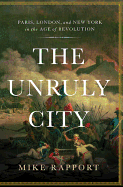
In The Unruly City, historian Michael Rapport (1848: Year of Revolution) considers how three cities--Paris, London and New York--became sites of social struggle in the period of the American and French Revolutions. He looks not simply at the events that occurred in each city, but how the cities as physical and social entities helped shape those events and were in turn transformed by revolutionary action.
Rapport gazes at moments of revolution, familiar and unfamiliar, through the lens of neighborhoods, buildings, physical icons and demographics. He creates a richly textured picture of 18th-century urban life, and how it varied among the three cities. For instance, he demonstrates how the composition and physical location of a neighborhood like the Faubourg Saint-Antoine in Paris made it part of the revolutionary vanguard. Likewise, he examines the transformation of the Common in New York, Saint George's Field in London and the Palais-Royal in Paris into popular gathering spots for the disaffected from all social classes. Considering institutions of revolt within the context of locale--coffee houses, taverns and, in the case of Paris, repurposed religious buildings--Rapport also explains the impact of meeting place on organization. In doing so, he traces the shift of activist locations from established meeting halls and courts to the spaces frequented by artisans and craftsmen.
In Rapport's hands, the cities become players in the story, not simply backdrops for the turmoil of the Age of Revolutions. --Pamela Toler, blogging at History in the Margins

